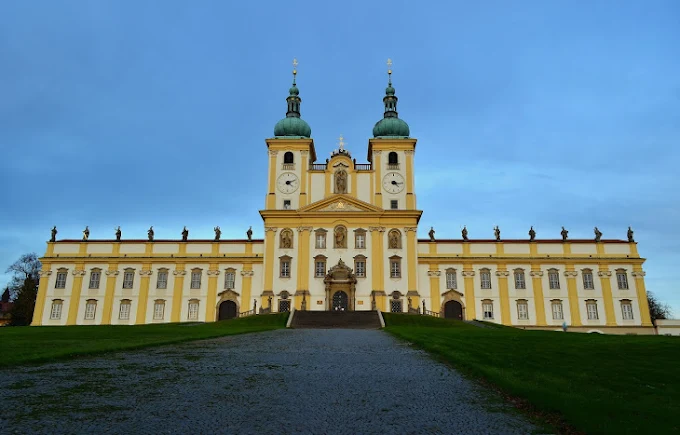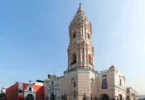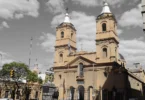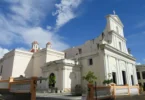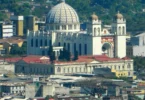Introduction
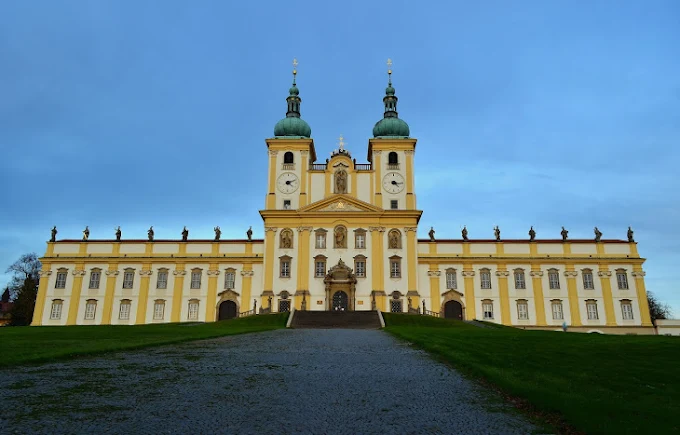
The Basilica of the Visitation of the Virgin Mary is a beautiful Baroque pilgrimage church sitting up on Svatý Kopeček Holy Hill just outside Olomouc. It’s part of the Premonstratensian monastery complex, and honestly, it’s one of the most striking landmarks in the area. You can see it from miles away it kind of watches over the whole region. This place has deep religious meaning for locals and visitors alike. Inside the basilica, there’s a rare relief of the Virgin Mary with the Child, and people here see it as a sacred symbol the palladium of the Haná region. It’s not just about the building; it’s what it represents. In 2018, the whole site church, monastery, and grounds was officially declared a national cultural monument of the Czech Republic, which just confirms how important it is, both spiritually and historically.
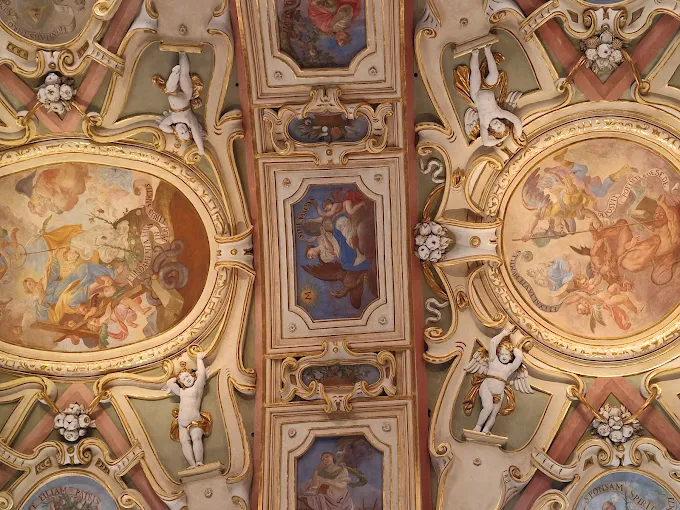
Chapel (17th century)
In the years 1629–1633, Jan Andrysek, a burgher from Olomouc, had a chapel dedicated to the Virgin Mary built at this place, originally called Svata Hora. It stood on a wooded hill on land owned by the Premonstratensian monastery Hradisko. Its most precious decoration was an altar with a stone relief of the Virgin Mary and the Child, to which pilgrims attributed miraculous powers. In 1645, the chapel was destroyed in a fire deliberately started by a Swedish soldier. In the post-war period, the restored chapel, including the saved holy image, became a destination for pilgrims from the surrounding area.
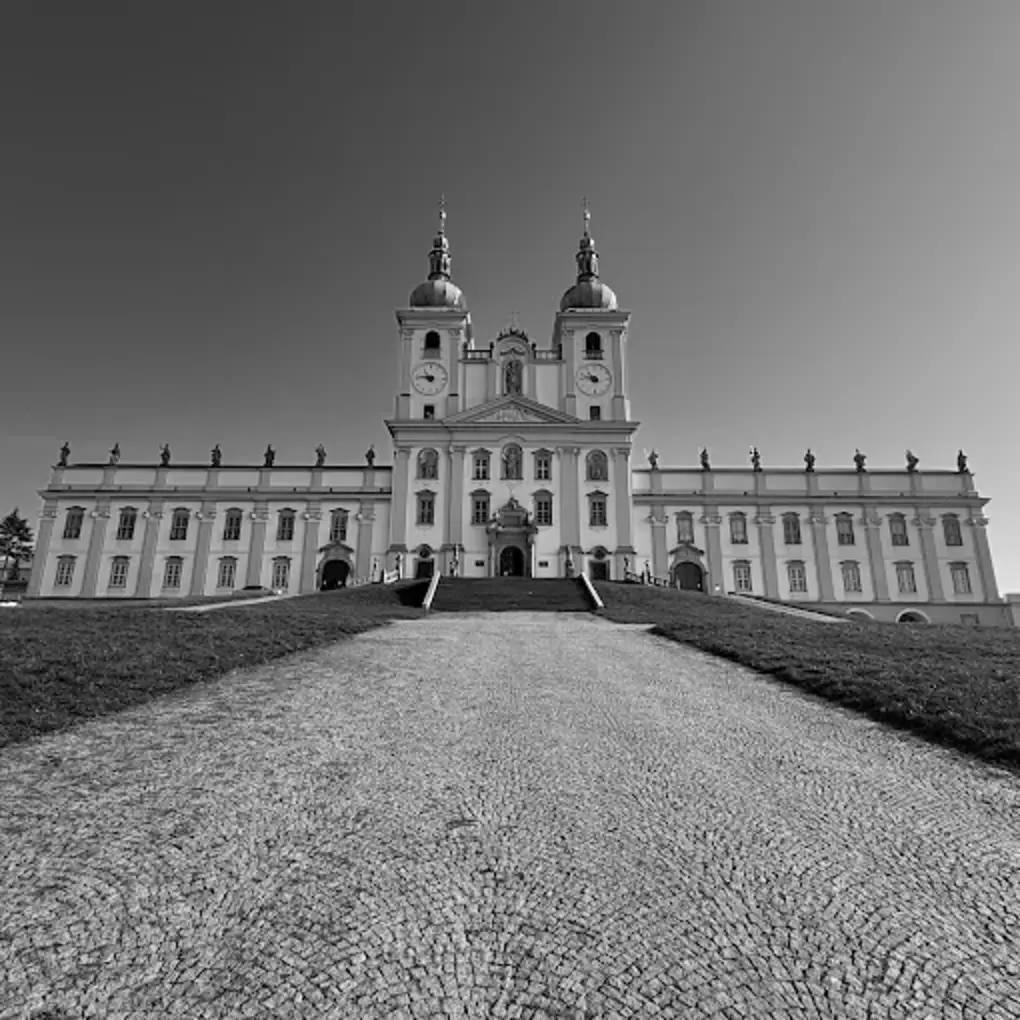
Church (17th–19th century)
The chapel was replaced by a new church, built by the Premonstratensians in 1669–1679. Giovanni Pietro Tencalla is usually considered the author of the project. The new church was consecrated on 1 October 1679 by the Olomouc bishop Charles II of Lichtenstein-Castelcorn. Soon after the consecration of the church, more than 50,000 pilgrims came here every year, and their number continued to grow. Between 120,000 and 130,000 pilgrims traveled annually around 1700. Along with the growth in the number of pilgrims, the number of priests working there also grew, from one (in 1672) to twenty (in 1700). At the beginning of the 18th century, the church hosted more than six thousand annual masses. In 1714, the Italian architect Domenico Martinelli added two-story buildings to the sides of the temple, which served representative and residential purposes. The temple underwent additional reconstructions from 1721 to 1732, during which time the Italian sculptor and stucco artist Baldassar Fontana designed a new interior. In 1732, two large Baroque celebrations took place in the basilica in quick succession. First, on September 8, there was a jubilee celebration to commemorate 100 years since the establishment of the pilgrimage site. The celebration was also attended by the Bishop of Sekavy (and later of Olomouc), Jakub Arnošt of Lichtenstein-Castelcorn. In the evening, after the end of the services, an “artificial fire” was staged in front of the Holy Hill. Throughout the octave, processions from all over Moravia headed to the basilica, with around 5,000 pilgrims arriving in the procession from Uničov alone. The following coronation celebration was even more magnificent. The coronation of the relief of love was facilitated by the Bishop of Olomouc, Wolfgang Hannibal of Schrattenbach, who made numerous intercessions in Rome. Unlike the previous coronation of the Madonna of St. Thomas, the following coronation of the Madonna of St. Thomas was also paid for by the Vatican Chapter from the Sforza Foundation. The crowns were brought from Rome to Moravia by Cardinal Schrattenbach himself and handed over to the abbot of Hradiště Norbert Umlauff, who brought them to the Holy Hill on September 18. The evening before the coronation, the Holy Hill and the road to it, the whole of Olomouc and the nearby Hradisko monastery were ceremoniously decorated. On September 21, the coronation itself took place.
About a million pilgrims attended both of the aforementioned festivals. At that time, the remains of the 14th Pope, the first martyr of Rome , Saint Victor, were also obtained from Rome for the church and placed in a glass coffin on the right pillar of the church vault (now the remains of Saint Victor are part of the monumental neighboring Baroque south altar). In 1784, by decree of Emperor Joseph II, the monastery in Hradisko was abolished, as well as the priory of Svatokopecke. In 1785, an independent rectory was established on Svatokopecke. In the following years, the church and the entire area fell into disrepair due to lack of funds. In 1846, it came under the administration of the Premonstratensians of the Strahov Monastery, who took care of the restoration and maintenance of the pilgrimage site.
Basilica (20th century)
At the end of World War II, the pilgrimage church was damaged by gunfire and fire on the night of May 6-7, 1945. During the following years, the church towers and external facades were restored. Since 1950, after the forcible expulsion of the Premonstratensians by the communist regime, the area has been under the administration of diocesan priests. In February 1990, it was handed over to the Strahov Premonstratensians again. Thanks to them, a new cultural and spiritual center of the city of Olomouc was created here. They created conditions for the activities of the church choir and the Matica svatokopecke, organizing exhibitions, lectures and similar events.On 21 May 1995, the Holy Hill was visited by Pope John Paul II , by whose decree the local church was also granted the honorary title of ” minor basilica ” on 11 April 1995. Since 17 May 2015, a reliquary with the remains (blood) of St. John Paul II has been placed on the pillar, in memory of the 20th anniversary of his visit to this basilica, which was personally brought here by the Archbishop of Krakow, Stanisław Cardinal Dziwisz. After the mass, the congregation in the church was greeted by Pope Francis from Rome via a large screen installed in front of the main altar after the Angelus. A solemn service and a cultural program for the church on August 17, 2017 (in honor of St. John Paul II here. “The Holy Hill is full of my sheep” on large screens) were held in front of the basilica, ending with fireworks as part of the National Youth Meeting in Olomouc (August 15-20, 2017). It was celebrated by Bishop František Václav Lobkowicz with the participation of the Primate of the Czech Republic, Cardinal Dominik Duka , the Moravian Metropolitan of Olomouc, Archbishop Jan Graubner , Stanisław Cardinal Dziwisz , the episcopal and priestly choir of the Czech and Moravian ecclesiastical provinces, the musical ensembles “Srdcari” from Prague and “Snezenky” from Olomouc, and ten thousand young believers, until late in the evening.
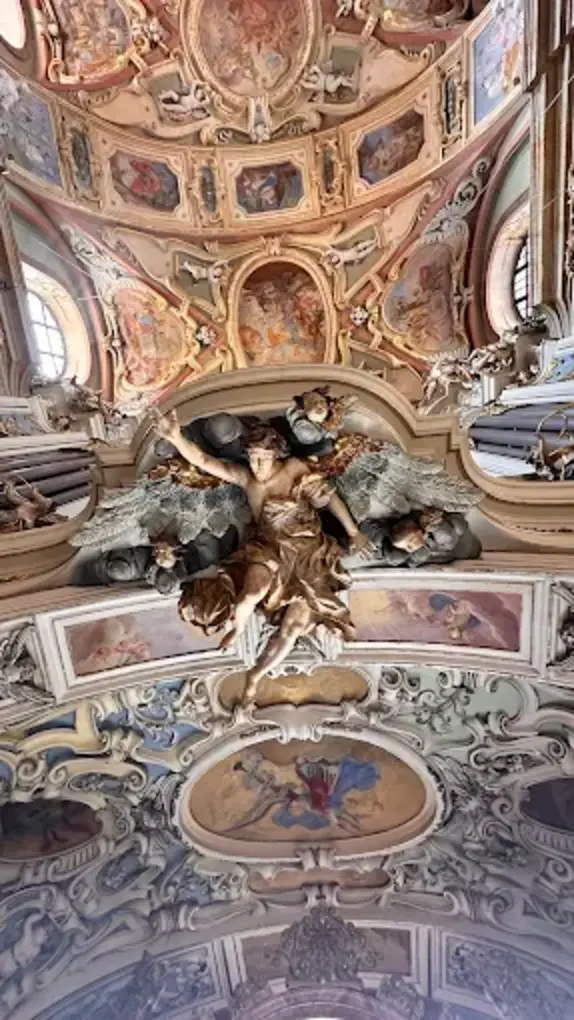
Construction and restoration of the area (21st century)
Between 1996 and 1998, a general renovation of the choir was carried out, during which a new organ was installed, all sculptures and the ceiling fresco were restored. In 2003–2007, extensive work was carried out on the temple buildings, the residence and the cloister . The roof trusses, roof coverings, windows and external facades were replaced. 14 statues from the attics on the residential wings were restored. In 2006, two new bells, Maria (820 kg) and Jáchym (600 kg), were purchased as compensation for war losses. In 2003, the Architectural Heritage Preservation Program provided CZK 1,000,000 for the monument’s repair. In 2007–2009, the first stage of the renovation of the basilica’s interiors took place, during which the decoration of the vaults and domes was restored. In 2008, the Matice svatokopecké Museum was established in the northern residence by the Holy Stairs. In 2011–2013, the external area in front of the entrance to the basilica was renovated, during which the statues on the facade were restored, the balustrade and the stone staircase were repaired. In 2018–2020, the interior of the basilica underwent a complete reconstruction as part of the second stage of the renovation project, during which the plaster, facades, windows, as well as the electrical installations, lighting, heating and sound systems of the entire historical monument were repaired. An important part was also the installation of new security and fire protection systems. Works of art such as sculptures, paintings, stained glass, the altar, the pulpit and all historical furnishings were also restored. The Holy Stairs and the Matice svatokopecké museum were also renovated as part of the restoration, which was carried out by a team of 30 restorers with varying specialties under the direction of academic sculptor and restorer René Tikal. The reconstruction cost 114 million crowns, much of which was covered by a subsidy from the EU.
Basilica administration
After the monastery in Hradisko was abolished, the Strahov Monastery took over the administration of the area . In 1902, the Strahov Premonstratensian Vojtěch Frejka restored the female branch of the Premonstratensian order here he founded the Congregation of Premonstratensian Sisters. The spiritual administration of Svaty Kopecek is still led by the Strahov Premonstratensians to this day (their small community lives in the local rectory). The Congregational Premonstratensians also run a hospice here.
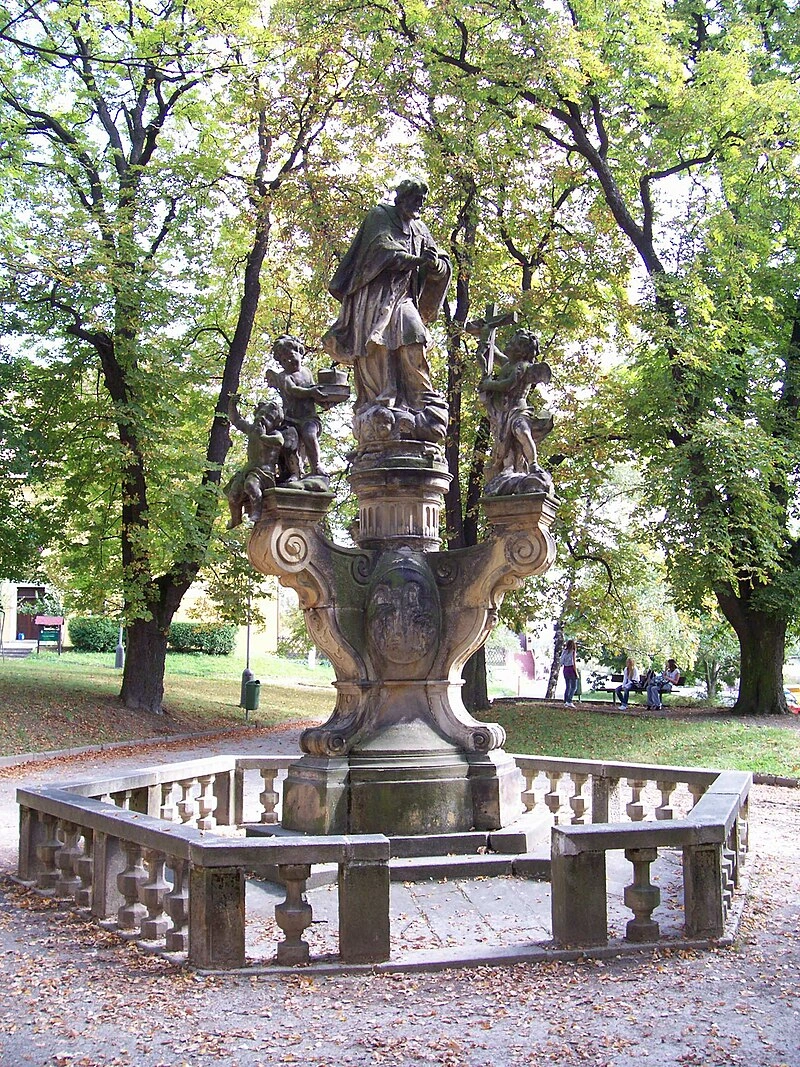
Surroundings of the pilgrimage site
There is a beautiful old pilgrimage path that takes you all the way up to the basilica from the Hradisko Monastery. It’s not just a path it’s lined with chapels, sculptures, and some seriously impressive statues. Along the way, there’s the Church of St. Barbara, and a statue of a pilgrim being guided by an angel, with a carving of the Virgin Mary of Svatokopecká in between. There’s also a group of six columns topped with statues of Christ and the Virgin Mary, plus statues of St. John of Nepomuk and Thaddeus. The whole alley is officially protected as a cultural monument, so it’s a big deal in Czech heritage. One of the standout pieces nearby is the big Baroque statue of St. John of Nepomuk on Sadové Square. It was made sometime between 1740 and 1745, probably by a sculptor named Jiří Antonín Heinz. The statue stands tall on a big pedestal, and the main figure St. John is life-sized, maybe even a bit larger. Around the base are three angels standing on these curled supports, and the whole thing is surrounded by a hexagonal stone railing. On the pedestal itself are carved scenes from his life, which add some cool storytelling to the whole setup. Not far from the basilica, there’s also a simple but meaningful cross that was put up in 1909 by the Skládal family they were the grandparents of the poet Jiří Wolker. They dedicated it to celebrate his birth. He was very close to his grandmother, Aneka, and used to visit there. It’s a sweet personal detail that adds a bit of warmth to the history of the place.
Architecture of Basilica of the Visitation of the Blessed Virgin Mary, Svaty Kopeček, Czechia
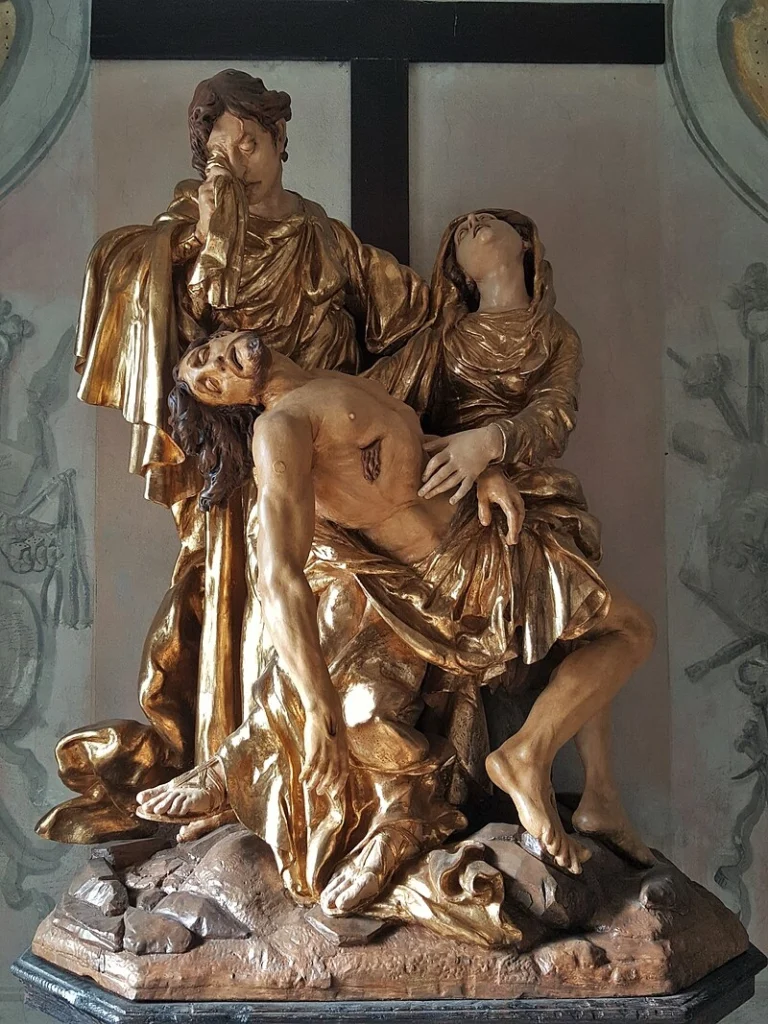
Architect :Giovanni Pietro Tencalla
Architectural style: Baroque architecture
The Campus
The Baroque pilgrimage church of the Visitation of the Virgin Mary on the Holy Hill with its two-towered facade is a prominent landmark in the landscape around Olomouc. It forms the main part of a closed pilgrimage site, which consists of a church, residential and purpose-built buildings and an cloister. The main axis of the basilica does not run from east to west, but the church is turned with its facade towards the mother monastery of Hradisko, about 6 km away. The church was designed by Giovanni Pietro Tencalla and is an example of Baroque landscape composition. The building of the church is flanked by residential wings with attics carrying statues of 12 apostles and two saints. The total length of the facade is 97 meters. Perpendicular to them are single-storey wings, which create unequally sized courtyard wings on the sides of the church. The building housing the holy stairs and the winter chapel seals off the northern wing. Behind the presbytery of the church is a large semicircular courtyard with a sculpture of St. Norbert. and an open cloister with the Stations of the Cross, in the center of which is built the chapel of the Name of the Virgin Mary. On the sides of the cloister there are two smaller chapels of St. Peter and St. Mary the Magdalene The architect of this part of the complex, which was created in the years 1714–1721, was Domenico Martinelli.
The Basilica
The heart of the entire complex is the impressive pilgrimage church, named for the event when the Virgin Mary visited her cousin Elizabeth in the Judean Mountains. The Catholic Church observes the Feast of the Visitation on May 31 to commemorate this visit. The story is closely tied to Mary’s hymn, the Magnificat, and the birthplace of John the Baptist.
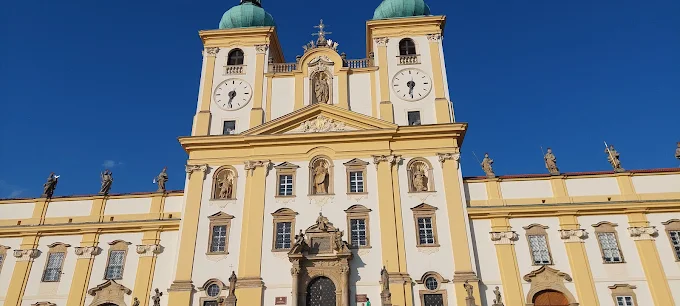
Exterior
In front of the facade of the basilica, which measures 25 meters, there is a terrace with a stone staircase equipped with a balustrade railing and sculptural decoration. In front of the temple on the staircase stand statues of St.Cyril and Methodius from 1909. The facade is horizontally divided into two parts by a prominently protruding cornice with a triangular gable in the middle. The upper part has two prismatic towers on the sides, 45 m high, with onion roofs with a lantern, connected by an attic . On each of the towers there is a clock in the middle, below them a window and above them a semicircular opening to the space with bells. Each tower is home to two bells. In the center of the attic between the towers there is a niche with a statue of the Virgin Mary with the baby Jesus. The lower part of the facade is dominated by a richly decorated entrance portal with a supraporta, which includes three figures considered allegories of the divine virtues – faith, hope and love. They were created in 1731 by the sculptor Josef Winterhalder. Between the figures is a stone slab with a Latin inscription commemorating the dates and people associated with the founding of the temple. On the sides of the portal are two side entrances. Above it is a niche with a statue of Saint Stephen, the patron saint of the Hradisko Monastery. In the extreme niches of the second floor of the facade are statues of Saint Augustine (left from the front view) and Saint Norbert (right). The author of the sculptures from 1678–1680 is the Olomouc sculptor František Zürn. The ground plan of the church is rectangular with a triangular end, the total length is 55 meters. The windows, most of which have semicircular arches, are lined with profiled stone chambrans, and the only thing that separates the side facades is recessed fillings. The lower parts of the side chapels, the sacristy and the oratory are attached to the main mass of the church, and the wing of the Holy Stairs extending to the north into the courtyard area. The roofs above the nave and the presbytery are gabled, the end has a triangular pyramidal roof, the lower side roofs above the chapels and the sacristy and the dome are hipped.
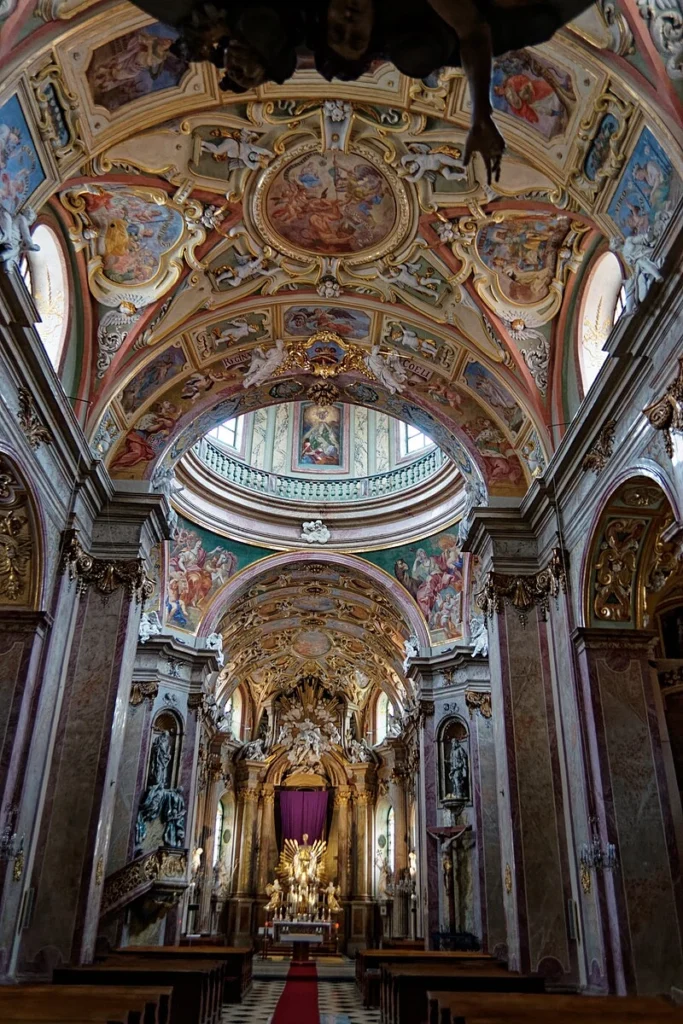
Interior
The basilica consists of a nave with eight side chapels. It ends with a presbyter, which has oratories on the sides of the floor. An organ from the early 1800s has been installed in the evangelical oratory on the left. Below it is access to the winter chapel, sacristy and the Holy Stairs. The intersection of the nave and transept is vaulted by a large dome with a lantern (diameter 11.5 m, height 30 m), in which is placed a dove as a symbol of the Holy Spirit. At the foot of the dome is a gallery lined with a balustrade, accessible from the attic above the nave. In the transept, the two largest chapels ( St. Joseph and St. Joachim ) are built opposite each other, the other four chapels on the sides of the nave have a lower vault and are walk-through. On the left side are the chapels of St. Augustine and St. On the right are the Guardian Angels, and St. Norbert and St. Pauline, patron saints of the city of Olomouc. Two smaller chapels (the Most Precious Blood of Christ and the Sorrowful Virgin Mary) were established on the ground floor of the towers. The original chapel from the early 17th century stood where the side chapel of St. Today, Pauline is located. On the western side of the nave between the towers is a choir with an organ. The church’s floor is made of marble, laid in 1977. Under the floor are three tombs in which the abbots of the Hradisko Monastery, priests from the Premonstratensian order and the townspeople of Olomouc were buried. The church’s interior was decorated in two stages: in the first period (1675–79), the vault was decorated, and in the second period (1722–32, at the side altars until 1738), the entire interior, down to the main cornices, was decorated. Many Italian and local artists participated in it. The vault above the nave, in the presbytery and chapels is completely covered with plastic stucco decoration and fresco painting.
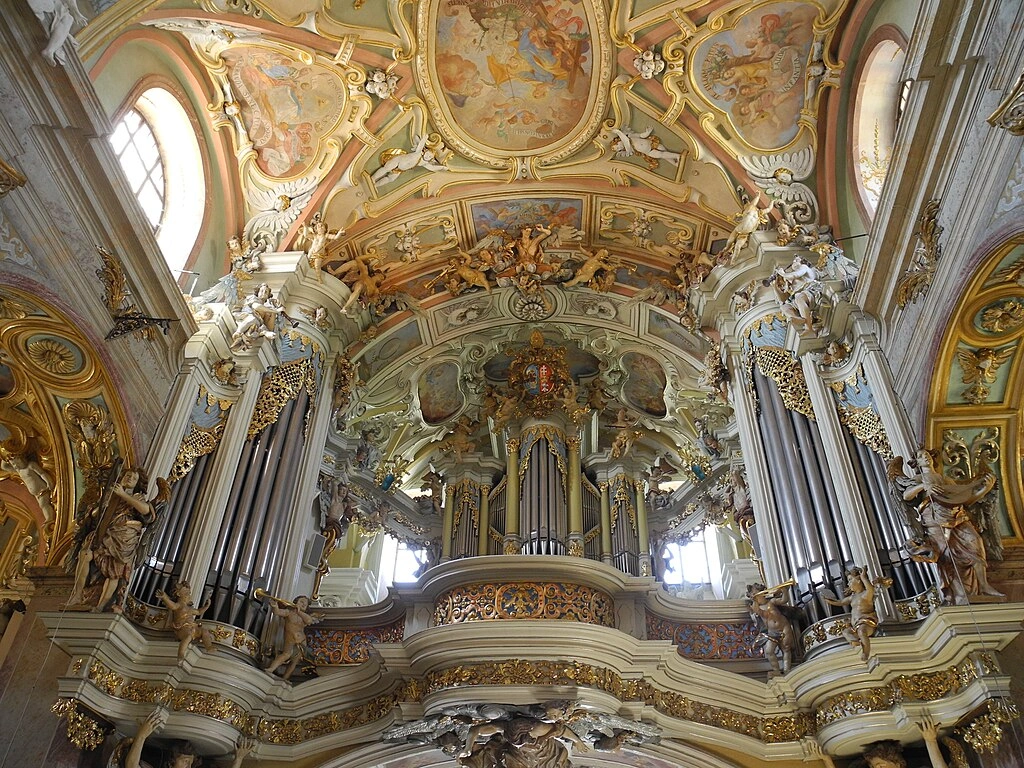
Presbytery
The frescoes of the presbytery vault are painted with symbols of the invocation of the Litany of Loreto. In the middle of the vault are three large frescoes: above the main altar of the Holy Trinity, in the middle part of the Glory of God and in the third square painting of the Assumption of the Virgin Mary. The rich stucco decoration of the vault with lunettes is in places up to 30 cm deep. On high pedestals in front of the windows stand statues of St. Augustine and St. Norbert. Baltazar Fontana created the main altar in the 1720s and 1730s. It consists of two pairs of columns with a gable extension and a plastic, richly gilded decoration with a statue of God the Father, surrounded by figures of angels. In the center of the altarpiece wall is set the altarpiece of the Visitation of the Virgin Mary from 1677 by the Viennese painter Johann Spillenberger. A free-standing altar mensa with a silver antependium is attached to a tabernacle with a canopy for a loving Marian image. On the sides are figures of angels. The tender image is a low relief in opal of the Virgin Mary and the infant Jesus, measuring 39 21.5 cm. The relief is encased in a wide, profiled silver frame and surrounded by a golden mantle adorned with Roman crowns. The modern renovation of the presbytery with a new marble altar, pulpit and pews was carried out according to the project of Ing. arch. In 1977, Tomá Ernouek was born. The vaults of the adjacent oratories were covered with frescoes with allegorical figures celebrating the virtues of the Virgin Mary in 1727 by the Olomouc painter Jan Kryštof Handke. Below the oratories are hung four silver-plated copper paintings with motifs reminiscent of important events from the early history of the church. They were made in 1739 by the Viennese goldsmith Jan Josef Wirth according to a design by Josef Winterhalder. An early 18th-century single-manual organ made by organist Jan David Sieber can be found in the oratories on the side choir. It is one of the oldest preserved organs in its original state in Moravia. The side doors from the presbytery on both sides are richly decorated with relief carvings with biblical motifs.
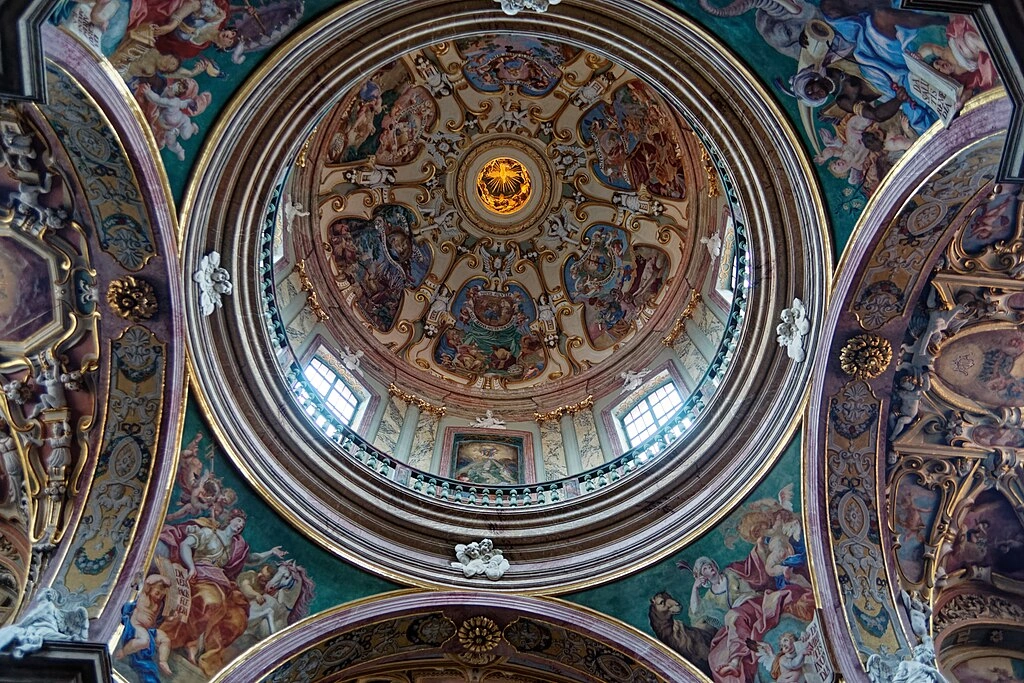
Main Nave
The nave’s barrel vault is decorated with large stucco cartouches featuring lively and expressive figures. The frescoes, painted on wet plaster, stand out with their bright colors and focus on celebrating the Virgin Mary. Above the triumphal arch, there’s a painting from 1732 commemorating the coronation of the Virgin’s love, surrounded by symbols representing all the countries of the Austrian monarchy at the time. The dome vault is adorned with six stucco cartouches containing frescoes that depict scenes from the lives of six Old Testament women, accompanied by the prayer “Hail, Queen.” The Viennese artist Jan Stegr created these and two other frescoes for the blind windows. In 1731, the painter Jan Kryštof Handke created allegorical figures of the four continents Europe, Asia, Africa, and America on the pendentives beneath the dome. Around the base of the dome, in niches on the four pillars, stand statues of the four evangelists: Matthew, Mark, Luke, and John. Michael and David Zürn sculpted these. Near the left pillar that connects to the presbytery is a pulpit without a roof, made by Josef Winterhalder in 1731. The main vault of the nave features two large oval frescoes. One shows Mary’s devotion to God, and the other depicts the archangel Michael battling the devil. In the four window lunettes, the praise of the Virgin Mary is symbolized by the four stages of human life childhood, youth, adulthood, and old age. The eight side chapels also carry rich stucco and fresco decorations, with altars set right against the church walls. Above each altar is a broken window topped with a semicircular arch. Paintings here are by Jan Kryštof Handke, Frans de Neve, Pavel Troger, and others. On the western side of the nave, the gallery is richly decorated with stucco and sculptural work. It once housed a Baroque organ built by David Sieber’s workshop in Brno between 1722 and 1725. Over the years, the organ was repaired and rebuilt several times. In the late 1990s, the Stavinoh brothers’ workshop from Valašské Meziříčí installed a new instrument inside the restored organ cases.
Side Rooms
Next to the pulpit is the entrance to rooms along the northern side of the basilica. A short corridor, which features a large Baroque wooden statue of the Madonna, leads to the winter chapel. Here you’ll find the Holy Stairs a set of 28 steps meant to recall the stairs in the Jerusalem palace that Jesus climbed before his trial before Pilate. At the top of these stairs stands a Pieta sculpture by Jiří Antonín Heinz. Most of the paintings in these rooms were done by Jan Kryštof Handke. In the corridors near the Holy Stairs, the Museum of the Holy Mount Athos was opened in 2008.

Other Buildings
Residences
The two wings of the two-story residential buildings each have seven pilasters on their facades, with two rows of rectangular windows framed in stone. Above the pilasters, a decorative cornice supports an attic lined with statues of saints. On the northern building (from the tower side), you’ll see statues of Peter, Andrew, John, James the Younger, Bartholomew, Simon, and Sebastian. On the southern building, the statues represent Philip, James the Elder, Thomas, Matthew, Thaddeus, and Roch. These statues were originally created by Jan Sturmer in 1725 and later modified by Josef Winterhalder. The two wings of the southern residence are shaped like an inverted T. On the ground floor near the church, there is a passage leading into the courtyard. The sloping terrain was cleverly used to build an open, arched passageway under the building that connects to an adjacent square with merchant shops. A two-flight staircase leads up to the courtyard, and a short corridor links the building directly to the church.
Northern Residence
The southern wing serves as the provost’s residence, and on the first floor, several historic representative halls remain. One of the most notable is the ceremonial Andrysek Hall, which boasts rich stucco work and walls covered with painted textile wallpapers depicting Marian legends of St. Kopecek by Pavel Troger. The ceiling features a large oil painting by Jan Krystof Handke, showing St.Norbert beneath the Cross of Christ, with the buildings of Hradisko and Svaty Kopecek in the background. Next is the small Chinese Hall, decorated with Chinese motifs on its walls, and the large French Hall, which displays portraits of former abbots of Hradisko Monastery. The ground floor rooms and corridors have vaulted ceilings with barrel vaults and sectors, while the halls upstairs have flat ceilings. The northern house serves as living quarters and has an L-shaped layout. In the corner of the first floor, there’s a smaller vaulted hall adorned with stucco and ceiling paintings. Several smaller buildings were added later to the side and serve practical, operational purposes.
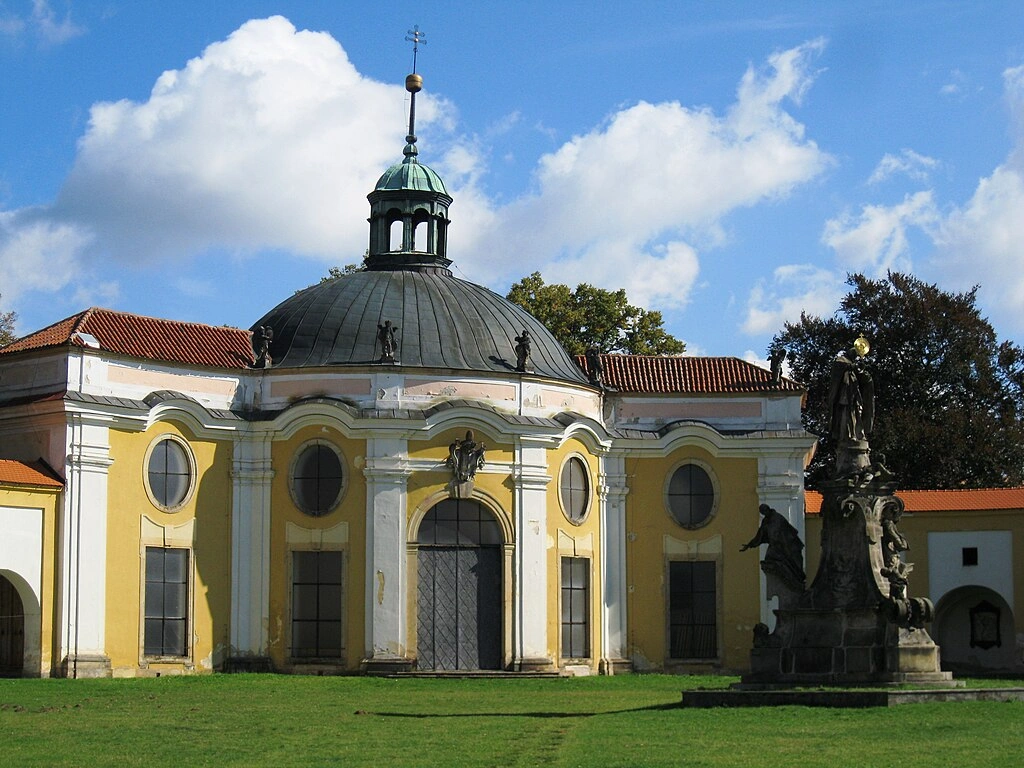
Cloister
On the eastern side of the pilgrimage site is a grassy courtyard enclosed by a semicircular cloister. The cloister looks like a solid wall from the outside, but inside, a series of semicircular arches lead into the courtyard. 14 Stations of the Cross were installed in 1940 in nooks along the cloister’s walls. These stucco reliefs, framed in pseudo-Baroque style, were carved by Olomouc artist Jaroslav Kubeček. At the southern end of the cloister stands a sandstone sculpture created in 1948 by Julius Pelikán. It honors the victims of the world wars. Two chapels of penance St. Peter and St. Mary Magdalene are incorporated into the cloister’s sides. They open onto the courtyard and have triangular gables with gabled roofs. Their stucco decoration was done by Baltazar Fontana.
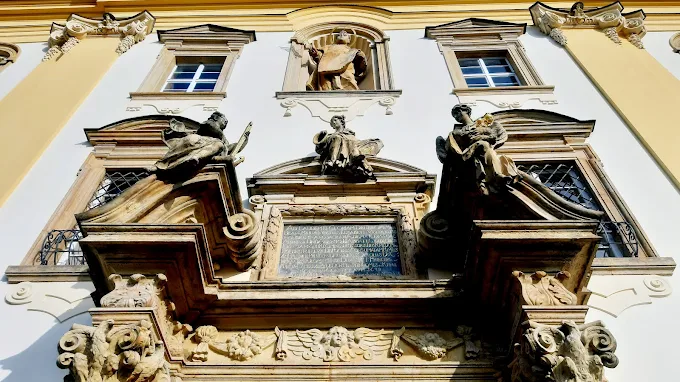
St. Anthony’s Statue and the Chapel of the Name of the Virgin Mary Norbert
On the easternmost side of the complex, the Chapel of the Name of the Virgin Mary was built into the cloister in 1718. This chapel dominates the courtyard with its oval floor plan. Wings extend from the chapel on both sides, connecting to each side of the cloister. The roof is an oval dome topped with a lantern and a finial. The chapel’s facade faces the courtyard, with a large double-winged metal gate as its entrance, topped by a semicircular transom. Smaller rectangular wrought-iron doors sit to the sides, with oval windows above them. Above the cornice is an attic decorated with statues of angels perched on pilasters. Inside, the dome’s ceiling is decorated with frescoes featuring figures from both the Old and New Testaments connected to the Virgin Mary. These paintings are attributed to Jan Kryštof Handke or Jan Michal Fisée. Baltazar Fontana created the sculptures of King Solomon and King David in the chapel’s stucco. In the side wings of the chapel are oratories, accessible by wooden spiral staircases. After 1780, priests were buried in the chapel, as shown by tombstones and slabs still preserved there. In the middle of the courtyard stands a large statue of St. Norbert, created in 1753 by Josef and Jan Winterhalder. This Baroque sculpture is about 8.5 meters tall. It shows the saint holding up a gilded monstrance and stands on a wide pedestal decorated with reliefs from his life. Two kneeling Premonstratensian martyrs flank the statue.
Feast Day
Feast Day : 31 May
The feast date for the Basilica of the Visitation of the Blessed Virgin Mary in Svatý Kopeček, Czechia, is May 31st. This date commemorates the Feast of the Visitation, celebrating the visit of the Virgin Mary to her cousin Elizabeth.
Church Mass Timing
Monday to Thursday, Saturday : 9:00 a.m.
Friday : 9:00 a.m, 6:00 p.m.
Sunday : 7:30 a.m, 10:00 a.m, 3:00 p.m.
Church Opening Time:
Mondayto : 8:30 am – 12:00 pm
Tuesday to Sunday : 8:30 am – 05:00 pm
Contact Info
Address : Basilica of the Visitation of the Virgin Mary
nám. Sadové 1, 779 00 Olomouc 9, Czechia
Phone : +420 606 775 911
Accommodations
Connectivities
Airway
Basilica of the Visitation of the Blessed Virgin Mary, Svaty Kopeček, Czechia, to Olomouc Airport, distance 25 min (14.6 km) via Route 35.
Railway
Basilica of the Visitation of the Blessed Virgin Mary, Svaty Kopeček, Czechia, to Olomouc hlavní nádraží (Olomouc Main Station), distance between 15 min (9.0 km) via Route 4436 and Route 35.

